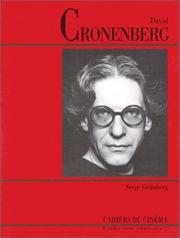| Listing 1 - 10 of 351 | << page >> |
Sort by
|
Book
ISBN: 9780810855854 0810855852 Year: 2008 Publisher: Lanham (Md) Scarecrow
Abstract | Keywords | Export | Availability | Bookmark
 Loading...
Loading...Choose an application
- Reference Manager
- EndNote
- RefWorks (Direct export to RefWorks)

ISBN: 9782866421199 2866421191 Year: 1992 Publisher: Paris: Ed. de l'Etoile,
Abstract | Keywords | Export | Availability | Bookmark
 Loading...
Loading...Choose an application
- Reference Manager
- EndNote
- RefWorks (Direct export to RefWorks)
Book
ISBN: 1786836343 9781786836342 Year: 2020 Publisher: Cardiff: University of Wales press,
Abstract | Keywords | Export | Availability | Bookmark
 Loading...
Loading...Choose an application
- Reference Manager
- EndNote
- RefWorks (Direct export to RefWorks)
The taste for horror is arguably as great today as it has ever been. Since the turn of the millennium, the horror genre has seen various developments emerging out of a range of contexts, from new industry paradigms and distribution practices to the advancement of subgenres that reflect new and evolving fears. New Blood builds upon preceding horror scholarship to offer a series of critical perspectives on the genre since the year 2000, presenting a collection of case studies on topics as diverse as the emergence of new critical categories (such as the contentiously named prestige horror ), new subgenres (including digital folk horror and desktop horror ) and horror on-demand ( Netflix horror ), and including analyses of key films such as The Witch and Raw and TV shows like Stranger Things and Channel Zero. Never losing sight of the horror genre s ongoing political economy, New Blood is an exciting contribution to film and horror scholarship that will prove to be an essential addition to the shelves of researchers, students and fans alike.
Book
ISBN: 9781538102435 Year: 2018 Publisher: Lanham (Md.) : Rowman & Littlefield,
Abstract | Keywords | Export | Availability | Bookmark
 Loading...
Loading...Choose an application
- Reference Manager
- EndNote
- RefWorks (Direct export to RefWorks)
Book
Year: 2023 Publisher: Ann Arbor, Michigan : University of Michigan Press,
Abstract | Keywords | Export | Availability | Bookmark
 Loading...
Loading...Choose an application
- Reference Manager
- EndNote
- RefWorks (Direct export to RefWorks)
In the 1960s, Suzuki Seijun met with modest success in directing popular movies about yakuza gangsters and mild exploitation films featuring prostitutes and teenage rebels. In this book, Peter Yacavone argues that Suzuki became an unlikely cinematic rebel and, with hindsight, one of the most important voices in the global cinema of the 1960s.
Book
ISBN: 1538102447 9781538102442 9781538102435 1538102439 Year: 2018 Publisher: Lanham, Maryland
Abstract | Keywords | Export | Availability | Bookmark
 Loading...
Loading...Choose an application
- Reference Manager
- EndNote
- RefWorks (Direct export to RefWorks)
Book
Year: 2023 Publisher: Ann Arbor, Michigan : University of Michigan Press,
Abstract | Keywords | Export | Availability | Bookmark
 Loading...
Loading...Choose an application
- Reference Manager
- EndNote
- RefWorks (Direct export to RefWorks)
In the 1960s, Suzuki Seijun met with modest success in directing popular movies about yakuza gangsters and mild exploitation films featuring prostitutes and teenage rebels. In this book, Peter Yacavone argues that Suzuki became an unlikely cinematic rebel and, with hindsight, one of the most important voices in the global cinema of the 1960s.
Book
ISBN: 9781476671536 Year: 2021 Publisher: Jefferson, North Carolina McFarland & Company Inc. Publishers
Abstract | Keywords | Export | Availability | Bookmark
 Loading...
Loading...Choose an application
- Reference Manager
- EndNote
- RefWorks (Direct export to RefWorks)
"The horror film is thriving worldwide. Filmmakers in countries as diverse as the USA, Australia, Israel, Spain, France, Great Britain, Iran, and South Korea are using the horror genre to address the emerging fears and anxieties of their cultures. This book investigates horror cinema around the globe with an emphasis on how the genre has developed in the past ten years. It closely examines 28 international films, including It Follows (2014), Grave (Raw, 2016), Busanhaeng (Train to Busan, 2016), and Get Out (2016), with discussions of another 100. Each chapter focuses on a different country, analyzing what frightens the people of these various nations and the ways in which horror crosses over to international audiences"--
Book
Year: 2023 Publisher: Ann Arbor, Michigan : University of Michigan Press,
Abstract | Keywords | Export | Availability | Bookmark
 Loading...
Loading...Choose an application
- Reference Manager
- EndNote
- RefWorks (Direct export to RefWorks)
In the 1960s, Suzuki Seijun met with modest success in directing popular movies about yakuza gangsters and mild exploitation films featuring prostitutes and teenage rebels. In this book, Peter Yacavone argues that Suzuki became an unlikely cinematic rebel and, with hindsight, one of the most important voices in the global cinema of the 1960s.
Book
ISBN: 9781622737420 1622737423 9781622739264 Year: 2020 Publisher: Wilmington (Del.) : Vernon press,
Abstract | Keywords | Export | Availability | Bookmark
 Loading...
Loading...Choose an application
- Reference Manager
- EndNote
- RefWorks (Direct export to RefWorks)
| Listing 1 - 10 of 351 | << page >> |
Sort by
|

 Search
Search Feedback
Feedback About UniCat
About UniCat  Help
Help News
News